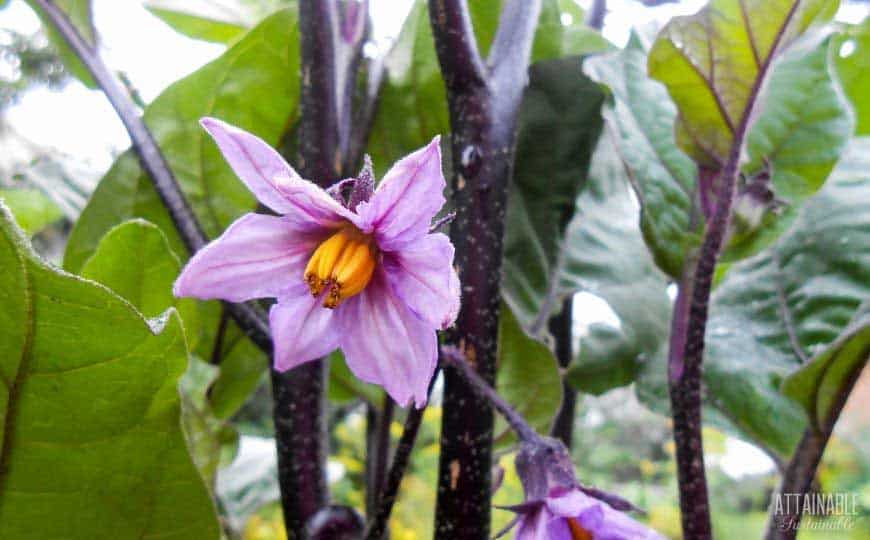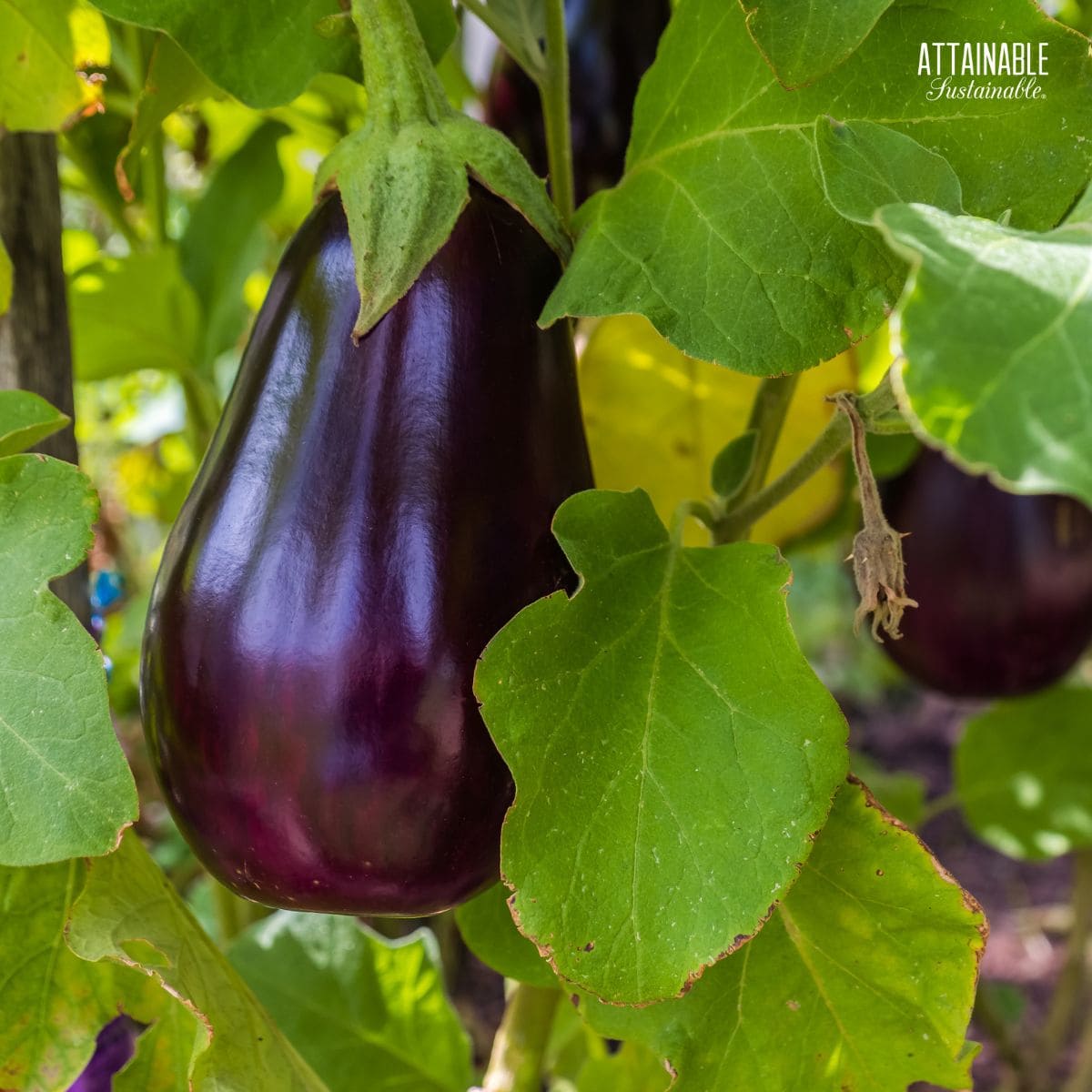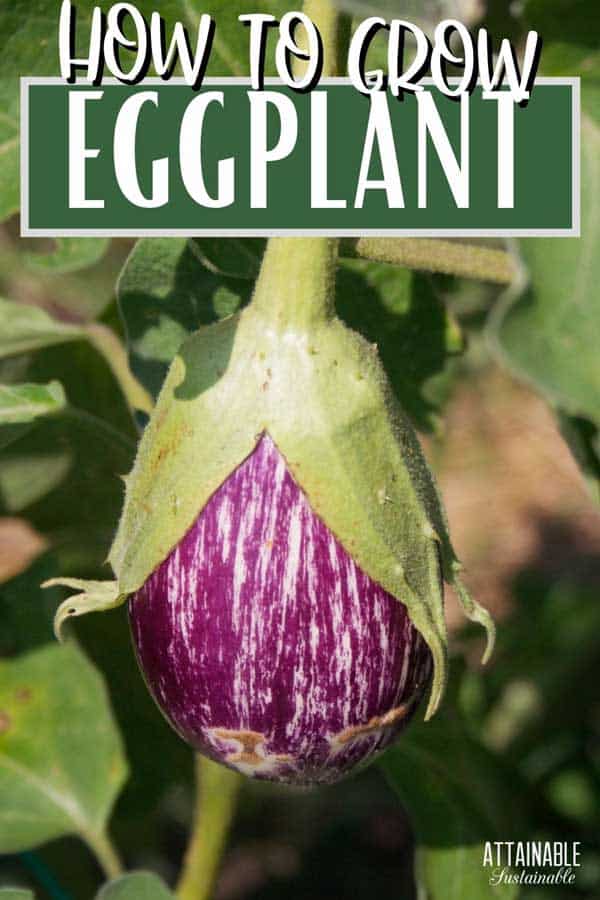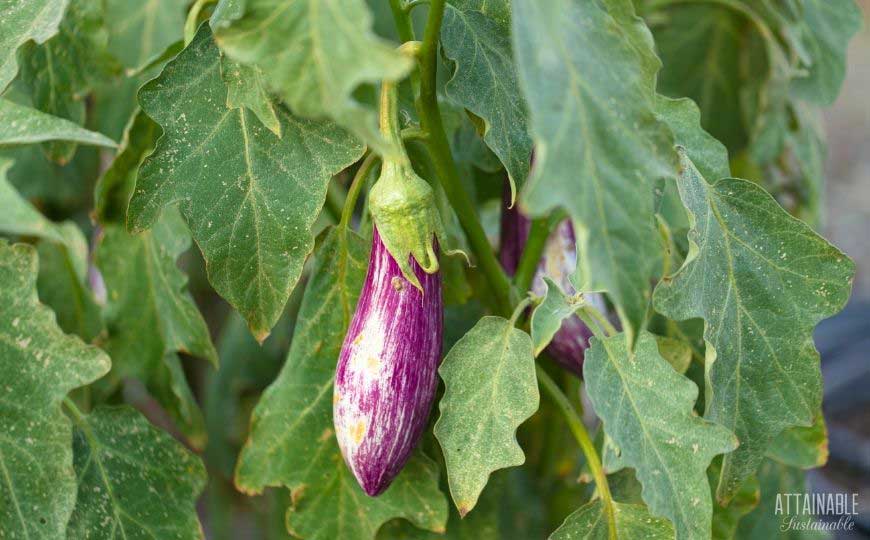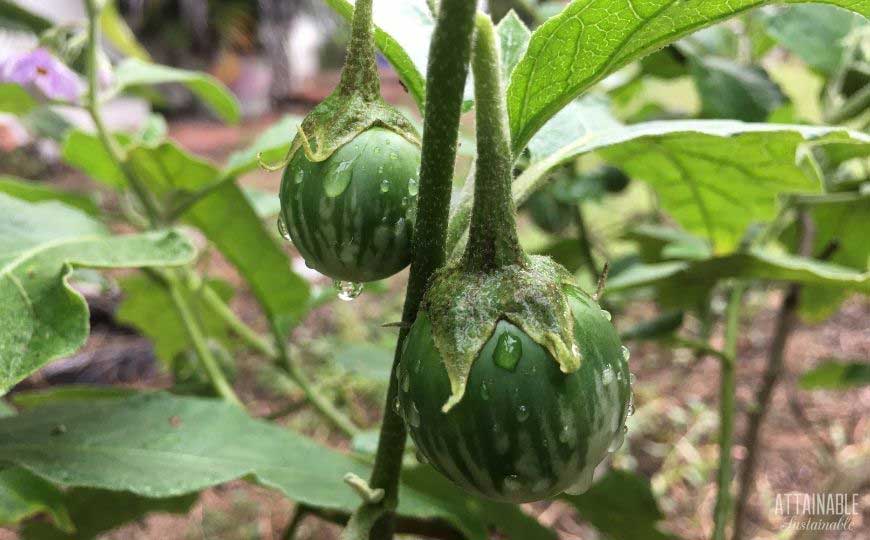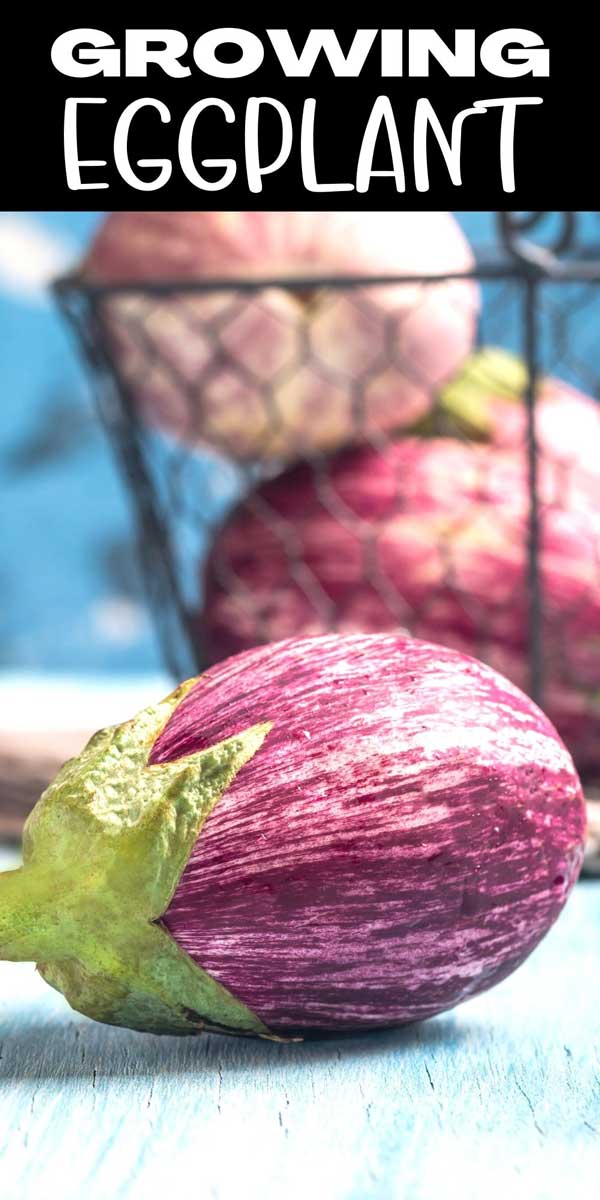Ready to grow eggplant in your garden for a delightful harvest? Read on to find out all about growing this eye-popping vegetable crop.
Contributed by Jodi Torpey, author and Master Gardener, in January 2021; this post has been updated.
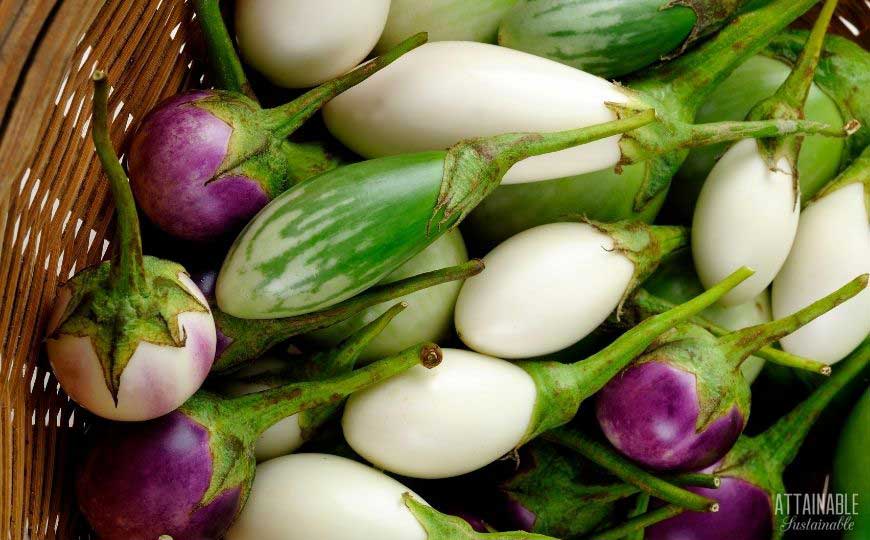
Eggplant is a member of the nightshade family, the same family that includes tomatoes, peppers and tomatoes. Not a fruit or a vegetable, eggplants are considered a berry, botanically speaking.
Eggplants are a versatile addition to either the vegetable or flower garden because they come in a range of sizes, shapes and colors.
Introduction to Eggplant (Solanum melongena)
Eggplant is a warm-season vegetable that grows as a perennial plant in tropical climates, but as an annual in cooler regions.
Like tomatoes and peppers, eggplants require a long growing season and are often started from seeds planted early in the season and then transplanted to the garden when the soil and temperature has warmed.
Grow Some Greens!
Ready to grow fresh greens, no matter WHERE you live? Sign up for my
FREE quick-start guide and start growing some of your own food!
For the best results in short-season regions, wait for warm days and nights before planting and choose eggplant varieties that have the shortest time to maturity, like 50-80 days from transplanting.
Choose From Many Eggplant Varieties
Most people are familiar with the large purple eggplants (often called Black Beauty) found at grocery stores, but there are dozens of other types of eggplants you can grow.
You can choose eggplant varieties based on how you’ll use them in your cooking. Asian types are excellent in stir fries and curries; eggplant Parmesan uses the large classic Italian type.
Every variety has something in common: beautiful plants with velvety leaves and pretty lavender, purple or white flowers.
Whichever eggplants you decide to grow, be sure to read the descriptions to learn about the fruits, their size and taste.
Here are a few eggplant varieties to get you started:
Standard Eggplants
Black Bell is a hybrid Italian eggplant in the classic oval shape. Dark purple fruits grow to 6-8 inches long; 68 days.
Traviata is another Italian-type eggplant that grows perfect deep purple 6–8-inch fruits than can be harvested through the season; 55-60 days.
Asian Eggplants
Millionaire is an Asian-type hybrid with long slender fruits that can grow to about 12 inches long and only 2 inches wide. Almost seedless, these eggplants are perfect for stir fry dishes; 62 days.
Ping Tung Long is a Japanese eggplant variety used for pickling. The fruits grow to 9 inches long and slender and have a sweet flavor; 65 days.
Specialty Eggplants
Annina is a purple and white striped heirloom eggplant with exceptional flavor; fruits are about 5 inches long and teardrop shaped; 69 days.
Japanese White Egg is an example of how eggplants earned their name. These small white, egg-shaped fruits grow to 2-3 inches, but have a rich eggplant flavor; 65 days.
Read about more vegetable plants that are pretty enough for the front yard!
How to Grow Eggplant from Seeds or Transplants
Eggplants can be grown from seeds or transplants, depending on your preference and your patience. Plants can be particular and need the right kind of care from the very start. Plants can suffer if they don’t get enough water, heat and light.
Start with Eggplant Seeds
If starting your own transplants from seed, allow at least two months from the time they germinate for the plants to reach transplant size. Eggplant can be temperamental, so baby them along with bottom heat and good lighting. Don’t let the soil dry out to prevent plant stress.
In regions with long growing seasons, direct sow eggplant seeds about ½ inch deep and 18-24 inches apart in garden beds.
Eggplant Seedlings
If buying transplants for your garden, select plants that are about 6-7 inches tall without any flowers or fruit on them. Keep garden center transplants in a warm location until the danger of frost has passed and it’s time to set them out in the garden.
When to Transplant Eggplants to the Garden
When it comes to planting eggplants, it’s better to wait until after your last frost date and for the soil and air temperatures to warm up than to expose eggplants to any cool weather. Even healthy plants can have a difficult time catching up after being exposed to cold temperatures.
Be sure to slowly acclimate transplants to the outdoors before planting into warm soil.
Plant eggplants when soil temperature is at least 70 degrees and when nighttime temperatures are a reliable 55 degrees.
Place young plants about 18-30 inches apart in rows that are at least 24 inches apart. After planting, add a support to each plant, like a tomato cage.
Requirements for Growing Eggplants
Light Requirements
Like tomatoes and peppers, eggplants need about 8 hours of full sun each day. Select the sunniest spot, whether in the vegetable bed, raised bed, container on the patio or even in the front flower garden.
Soil Needs
Eggplants grow best in fertile, well-drained soil with plenty of organic matter. Dig in compost, well-aged manure or other organic soil amendment before planting.
Eggplant can also grow well in a large container where you have more control over the soil fertility. Plan on fertilizing plants about once a month through the season to increase eggplant yield.
The plants can be heavy feeders. As plants start to grow, side dress with a well-balanced fertilizer (like 10-10-10) or compost. Sprinkle the fertilizer between plant rows, about 12 inches away from the base of the plants. Water in.
Water Requirements
Set up a drip system or soaker hose to ensure consistent and deep watering. A layer of organic mulch, like straw or dry shredded leaves, will help maintain soil moisture and reduce the need for weeding.
Uneven soil moisture can show up as blossom-end rot or poorly formed fruit, so make sure to keep up with consistent watering.
Combatting Pests and Other Problems
Eggplants can have the same insect pests and disease problems as tomatoes and peppers. Good cultural practices, will reduce or eliminate some issues. Maintain good watering practices, because plants will stop flowering and fruiting if they experience dry conditions. The result will be poor yields of fruit and the potential for blossom-end rot.
If you notice small holes in the leaves, eggplant flea beetles may be to blame. Use row cover cloth, tightly sealed at the edges, to exclude flea beetles until plants begin to flower. Then remove cover cloth to help with pollination.
Prevent problems with soil diseases, like verticillium wilt, by rotating where you plant eggplants and avoid planting where tomatoes, peppers and potatoes grew in the last 2 or 3 years.
Grow Eggplant in Containers
One benefit of growing eggplants in containers is that you can give the plants a head start in cooler climates. Plant them in a pot that you keep in a protected place until you can move them outside for the warm season.
Select a smaller variety meant for container growing, such as Patio Baby or Little Prince, compact varieties that both produce large crops on small plants. Plant in a large container filled with a good quality potting soil that includes a slow-release fertilizer.
Plan ahead and add a tomato cage or other type of support to the container to keep plants upright. Water deeply and consistently to keep soil moist, but not soggy.
How to Harvest Eggplant
Keep track of the estimated days to harvest for the eggplant varieties you planted, but you’ll likely be harvesting this crop in late summer. It’s important to cut eggplant fruits from the plant while the skin is still glossy and before the seeds have a chance to harden.
A good test for eggplant is to use your thumb to gently press the skin. If the indention springs back, the fruit is ripe and ready to cut from the plant.
Handle eggplants with care because they bruise easily; prepare and eat as soon after harvesting as you can.
Once they reach their mature size, use a sharp knife or hand pruners to harvest the fruit. Eggplant stems are very sturdy and won’t break or twist off easily like a tomato would. Be mindful of the sharp thorns growing on the plant!
Using Fresh Eggplants in Recipes
Eggplants don’t hold long after harvesting, so plan to use them as soon as you can. Store in a cool, dry place like the refrigerator vegetable drawer. When picked young, the skin is edible, so no need to peel for most dishes.
Cut into eggplants right before preparing to prevent discoloration; some recipes suggest cutting, salting and letting them sit for 20-30 minutes to reduce the water content.
Prepare in Italian, Greek, Asian, Turkish, Spanish, Indian, and French recipes by baking, broiling, roasting, grilling or frying.
Saving Eggplant Seeds
If you want to save eggplant seeds, plan ahead. Choose only heirloom or open pollinated varieties—not hybrids.
Plant only one variety or separate varieties by planting at least 300 feet apart to prevent cross pollination.
Wait for eggplants to turn color and for skins to become dull. Remove mature seeds from the flesh, rinse, dry and store in an airtight container.

